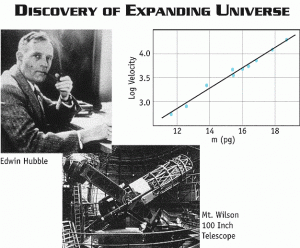Science Seen Physicist and Time One author Colin Gillespie helps you understand your world.
A Cosmic Puzzle Provides Insights into New Physics
A new cosmic contradiction is begging for an explanation. We’ve known for years that space is expanding. Now new measurements of the rate at which it is expanding seem to differ from previous ones based on the standard cosmological model. New physics often comes from measurements that don’t fit theory.
Here is my take on this: Maybe this misfit at the scale of the whole universe will help us understand at the smallest scales exactly what space is.
Ever since Edwin Hubble first found evidence the universe is expanding astrophysicists  have devised various methods to measure the expansion rate, called the Hubble constant. Last year, astrophysicists interpreted cosmic background radiation data from the Planck satellite looking at the furthest reaches of the visible universe. They applied the standard cosmological model based on general relativity to get a new and more accurate value of the Hubble constant. It disagreed with other measurements, but this could have been due to imprecise methods.
have devised various methods to measure the expansion rate, called the Hubble constant. Last year, astrophysicists interpreted cosmic background radiation data from the Planck satellite looking at the furthest reaches of the visible universe. They applied the standard cosmological model based on general relativity to get a new and more accurate value of the Hubble constant. It disagreed with other measurements, but this could have been due to imprecise methods.
The latest study used the Hubble Space Telescope. It looked at so-called standard candles (fluctuating stars called Cepheid variables) in regions of space within two-hundred million light years from Earth (a region that the authors, with straight faces, call “local”). It achieved much better accuracy. The discrepancy is still there. After making all allowances for possible errors it seems to be real. What is this telling us?
Back to my take on it: Could this discrepancy, measured over vast distances, tell us something about physics at the very smallest scale?
If so, it could help to solve what seems an insoluble problem. We can foresee that Planck-scale physics will lead to a new scientific revolution. But Planck scale is almost inconceivably small. Smashing atoms down to Planck size would take far more energy than we will ever muster. How then can we study Planck-scale physics? I say the answer’s written in the heavens. We can indeed study the inconceivably small by looking at the unimaginably large.
How so? With our most powerful telescopes we can see the universe’s history. As we look far out in space we look far back in time. We now have ways (most recently with that Planck satellite) to look back almost fourteen billion years to see a record of events less than 400,000 years after the universe began. To get a sense of scale consider that in terms of human lifespan this is less than one day old. The discrepancy in expansion rates may be telling us that Planck-era events are not well described by today’s physics.
Imprinted on the early universe are records of even earlier events just after the universe began. In this era, the first 10-42 s, (let’s call it the Planck era) the size of the entire universe must have been Planck scale. Space was made of only a few Planck-sized quanta. Some physicists speak airily about quantum mechanics leading to random fluctuations in the Planck era. Actually, like general relativity, quantum mechanics tells us nothing of this era. Quantum mechanics describes average behavior at vastly larger size scales and over far longer periods of time.
We have no theory of Planck-era physics. Three things will be needed to create one: first, an idea of what happened in that era (such as is described in Time One); second, a mathematical treatment of it (this may be the hard part); and third, experimental measurements that can be used to check the theory out. Measuring how fast space is expanding is just one example of ways astrophysics can give us a window into the Planck world.
Today’s physics is a story that we tell ourselves to help us grasp what we see of the world around us. Past changes to the physics story transformed the economy. Planck-scale physics will, for the first time, tell the story of the world as it really is. And so the coming change may be by far the biggest.
Sources:
Peter Ade et al. (the Planck Collaboration, 2015), “Planck 2015 results. XIII. Cosmological parameters”, Astron. & Astroph., vol. 571, p. A16; http://www. arXiv:1502.01589
Adam Riess et al. (2016), “A 2.4% Determination of the Local Value of the Hubble Constant”, Astroph. J., in press; http://www. arXiv:1604.01424v1
Image credit: NASA, http://map.gsfc.nasa.gov/universe/bb_tests_exp.html

No comments yet.